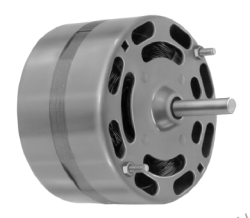
I have a vent fan in my attic. It’s “green” because it helps keep my home cool without using air conditioning. But not very green. It uses a 1/10 HP shaded-pole ac motor. The shaded-pole motor is low cost and simple. It suffers from low starting torque, typically 25% to 75% of the rated, and generally the efficiency of this motor type is very low (below 20%).
I wanted to improve on this efficiency by going to a permanent split capacitor (PSC) type when the current motor died this month but, unfortunately, I couldn’t find a physical match at 115 v and 1,050 rpm. This motors nameplate says 3.4 A, though it runs at about 1.5 A in my application. A PSC motor would take half that, or less.
And, when an induction motor starts it will draw very high inrush current due to the absence of the back EMF at start. So you don’t want to use these where the motor is turned on and off a lot. I could have gotten a two speed motor (dual windings) and a thermostat to match; but I had trouble finding an inexpensive dual-set thermostat.
For industrial use
For industrial apps, one can get a good variable speed AC motor controller for $175 and a ¼ HP motor to go with it for about the same money. The 3-phase motor is probably 92 to 96% efficient and the controller might be 85 to 90% so the energy savings is considerable.
Pay-back estimates for industrial motor applications from the Department of Energy show a $17 a year savings for each percentage point of efficiency gain for a 5 Hp motor operating 24/6 and $142 for each percentage point for a 50-hp motor. So, if you can replace a 75% efficiency 5 Hp motor with one that is 85% efficient you will save $170 in the first year of operation.

Many motor and controller manufactures have the word ‘efficient’ all over their web site and their white papers but nowhere on the site do they actually state their efficiency! And then they really should state how they determined the efficiency. In the United States, the recognized motor efficiency testing protocol is the IEEE 112 Method B, which uses a dynamometer to measure motor output under load. Different testing methods yielding significantly different results are used in other countries. So that’s what you would like to find motor data.
Most motor manufactures now make premium energy efficient models. They can improve efficiency from three to eight percent with heavier wire, higher core-steel grade, thinner core laminations, and better bearings. And even though initial cost is higher payback can be very short, especially for motors that are in constant use.
Designers should also be careful to size motors for efficiency. Motors should operate with a load factor between 65% and 100%. The common practice of over sizing results in less efficient operation. A motor operating at a 35% load is less efficient than a smaller motor that is matched to the same load.
In many applications, the input power is a function of the speed like fan, blower, pumps, and so on. In these types of loads, the torque is proportional to the square of the speed and the power is proportional to the cube of speed. Variable speed, depending upon the load requirement, provides significant energy saving. A reduction of 20% in the operating speed of the motor from its rated speed will result in an almost 50% reduction in it’s input power.
Some Web sites to reference
Microchip (www.microchip.com) has some excellent application notes on their site. I recommend one called AC Induction Motor Fundamentals (AN887). Freescale (www.freescale.com
) has a reference design titled PWM Control of the Single-Phase A.C. Induction Motor Using the MC68HC908QT4 MCU that might be a big help. And, Texas Instruments has nineteen application notes on this subject. Start at focus.ti.com/docs/solution/folders/print/195.html
.
Advertisement
Learn more about Electronic Products Magazine





